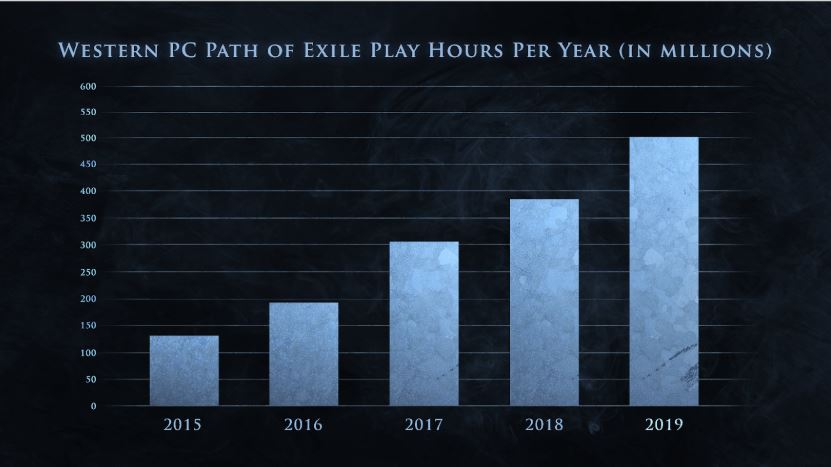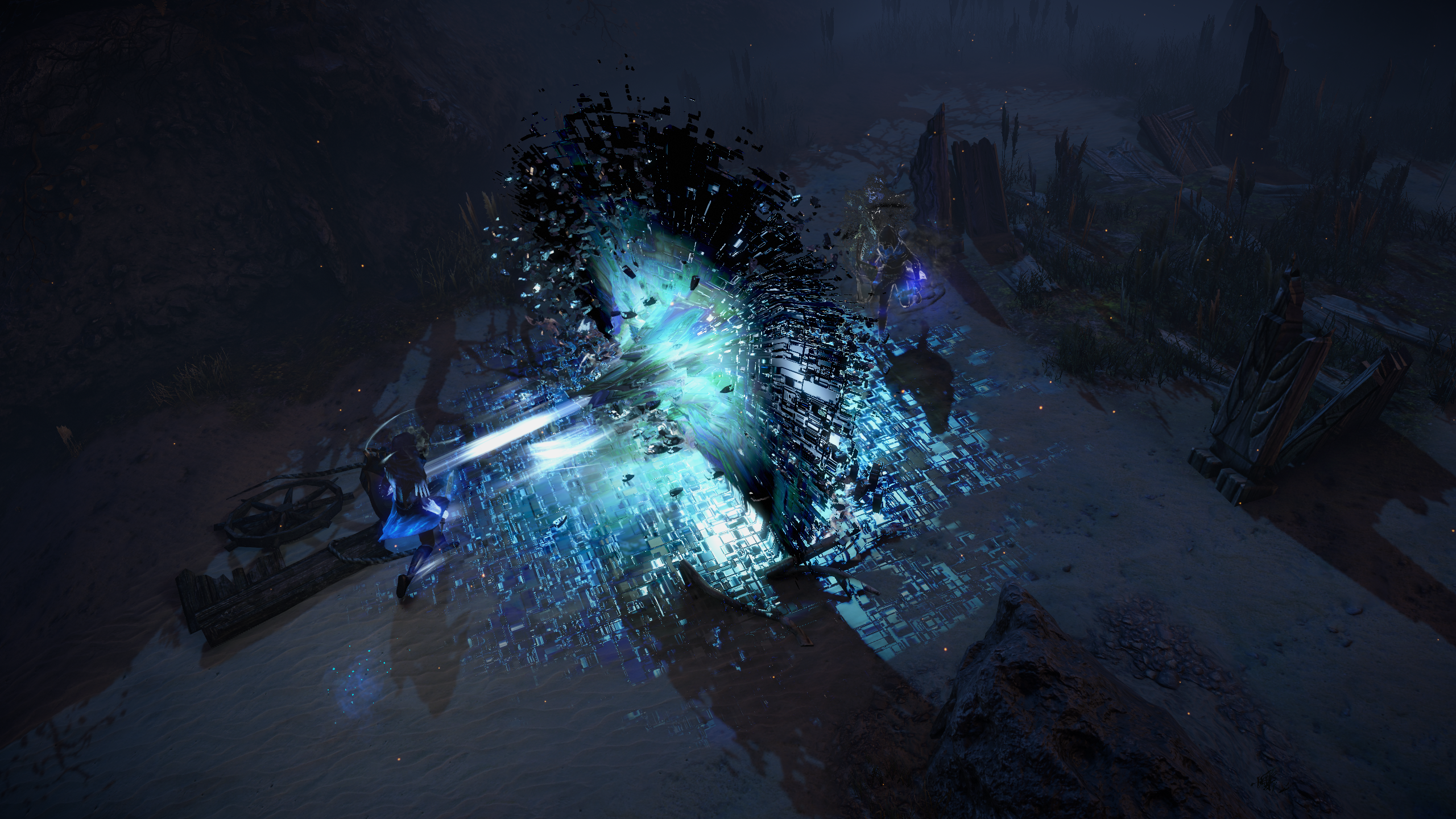2019 is turning out to have been one heckuva year for Path of Exile. Grinding Gear Games announced Path of Exile 2 and Path of Exile Mobile in December, and it turns out players were already excited about the online action-role-playing game before any of these details.
Path of Exile saw one of the greatest increases of play time on its Western servers in its five-year history. Grinding Gear Games general manager Chris Wilson (no relation to the writer — Ed.) shared the details while giving a presentation about the Delirium expansion in the 3.10 update coming March 13 (and one week later for PlayStation 4 and Xbox One). This spike in growth from 2018 to 2019 is roughly the same, numbers-wise, as what Grinding Gear saw between 2016 and 2017, though that one had a larger percentage of growth because the player base was smaller then.
This comes off another nice growth spurt after the Betrayal expansion, which launched in late 2018.
“I’m pleased to see both growth and the fact that the number of players that we added between 2018 and ’19 in terms of play hours was basically the same as the amount of people playing in 2015,” Wilson said Monday over a video call. “That’s quite a lot of growth, and hopefully, we can keep it up for as long as we can do so.”
June 5th: The AI Audit in NYC
Join us next week in NYC to engage with top executive leaders, delving into strategies for auditing AI models to ensure fairness, optimal performance, and ethical compliance across diverse organizations. Secure your attendance for this exclusive invite-only event.

Above: Player hours were on the rise again in 2019.
This doesn’t include increases in China and Taiwan, Wilson said, because Grinding Gear Games would need permission from its partners in the regions to reveal those numbers. The studio no longer reports specific player numbers, opting to instead track player hours or concurrent players (as it did when noting that Betrayal had nearly 200,000 concurrent players at one point).
Path of Exile launched in 2013 for PC, and it has steadily expanded both regions and platforms since. It came to Xbox One in 2017 and PlayStation 4 in 2019. And it hit China in 2017, bringing the game to a key region that enjoys PC free-to-play games and action-RPGs.
Needs of the many
Path of Exile continues to release expansions and tech updates several times a year, along with new cosmetics (Grinding Gear’s main approach to monetization is by selling cosmetics, along with more server options, character slots, and other things that don’t affect moment-to-moment gameplay). Many of the updates address player requests. For Delirium, Grinding Gear is working on improvements to skills and wands, for example. But this also comes from learning how to update a free-to-play online action-RPG over the years — after all, it’s not like there’s a roadmap. Path of Exile was one of the first such games to launch.
“I think we’re doing things right, and releasing content that people enjoy,” Wilson said. “There’s a lot of thought that goes into making sure that we’re releasing content that fits the Path of Exile, and I feel we floundered a little there in the first couple of years after release.”
I asked if the successful growth is because Grinding Gear has gotten better at making expansions, or if it’s because the company has learned lessons from producing endgame gameplay for several years.
“There is a recipe to Path of Exile content that includes something for everyone. We’ve got several player demographics, and we’re going to hit each one with content that they’ll enjoy,” Wilson said. “It took us a while to work out that mixture.”
Those early expansions focused completely on additions to story, character customization, or the early game, with “not enough emphasis on hitting something for all players,” Wilson said. “And while that really satisfied that group of players, it didn’t really cause actual growth in player numbers because other people felt underserved.”
Another reason for the growth, Wilson said, is part of a larger trend with action-RPGs — story.
“So as you’ve seen with recent RPG releases, action-RPGs with a large single-player campaign that you can play through just get a lot of attention. Everyone loves playing through new storyline content in these games, so if you can dump a bunch of acts on someone, you get a lot of extra playtime,” Wilson said.
Carrying over
Another way Grinding Gear hopes to keep players — and increase those player hours — is by enabling folks to bring their characters and microtransactions from Path of Exile to Path of Exile 2. You’ll be able to play from the same client, and some of the improvements from the sequel will find their way into the original.
Path of Exile 2 will have a seven-act storyline, 19 new ascendancy classes, a slew of new monsters and items, character models, animations, and more.
“We wanted to add a true sequel that’s sitting aside Path of Exile 1,” Wilson said. “There’s no segregated community. There’s a shared endgame, so regardless of which storyline you prefer — there will be some diehard people who put their foot down and say, ‘No, I like the original better’ — those people will still get to play and meet up in the endgame with their friends who are playing the new content. It also means that many of the improvements to Path of Exile 2, like new rigs for the characters and new effects, can affect Path of Exile 1 because they’re still in the same game. So it’s not like abandoning the old one and working on the new one; it’s an effort to maintain the old one beside the new one.”
As an example of how different Grinding Gear’s model is, character and cosmetics don’t carry over from The Division to The Division II.
Getting Delirious

Above: Step into the mirror … and prepare to face a horde of monsters.
The Delirium expansion is the 3.10 update to Path of Exile, and it’s coming March 13 to PC (and one week later to PS4 and Xbox One). It’s the first expansion for 2020, and it brings in the following changes:
- The Mirror of Delirium: A mirror appears in each area, and it bears a reflection of your character. Entering the mirror takes you into the “state of Delirium” for a short time, in which you fight a host of monsters.
- You enter an area shrouded in mist … and full of monsters. The existing creatures have new abilities, and Delirium spawns different monsters as well.
- The further you range from the Mirror, the more monsters you encounter. This enables you to have a bit of control over the difficulty you encounter. But the deeper you go into the mists, the greater the challenge … and the loot … becomes.
- In Delirium, powerful monsters get an additional boost — they can manifest mighty demons that attack you.
- Delirium can seep into every corner of Path of Exile, including Act Bosses and other major encounters.
- Delirium’s core combat feels similar to expansions and leagues like Breach, but you have control over the difficulty, and it stacks with other Path of Exile content. It’s not a self-contained encounter, like Delve.
https://youtu.be/oO3gLp__tRg
- Each area has a specific type of random Delirium reward. Grinding Gear’s examples include currency items, map items, and a rare armor piece. If you slay enough monsters inside Delirium, you receive one of these treasures. Once you do, it resets progress, and while you can earn another item, its returns just aren’t as good as with the first you get.
- Endgame maps have Delirium encounters like the rest of the game.
- You can find Orbs of Delirium, which you can use on maps to uniformly apply Delirium to that map. Each additional Orb boosts the density of Delirium, making it harder and more rewarding. Each Orb has a reward theme as well, setting it for that map. By doing all of this, players can make endgame maps harder with hellacious difficulty.
- The Delirium League also has special cluster jewels that can greatly expand your passive skill tree. You put them into external sockets of the tree to create new passive skill clusters, which can then have their own additional sockets. Grinding Gear notes this is the biggest change to building characters since Ascendancy classes in 2016.
- The Metamorph League, Grinding Gear notes, was so popular that it’s going to become part of the core content for Path of Exile. You’ll encounter it occasionally.
Skills for the bills
https://youtu.be/pa9BIbCnwJQ
Wilson notes that Grinding Gear has for some time been focusing on specific archetypes and creating new skills for them. Delirium is going to add new skills for any archetype.
The first is a new skill called Blade Blast. Previously, all Blade skills left blades on the screen. Blade Blast makes them explode, harming all foes in their area of effect. You can also use Animate Weapon to animate the blades left behind by Blade skills.
And if you enjoy using Wands (as I do), you will get Kinetic Bolt. Recognizing it has ignored Wand wielders, Grinding Gear said it wanted to add a skill that works well at low levels and can scale to the endgame. Kinetic Bolt creates a forking bolt that dishes out physical damage with what the studio calls a “solid” area of effect. It can combo with support gems like Barrage as well.
New loot!

Above: The Algor Mortis will enable new cold/lightning combos.
Delirium is bringing 13 new unique items. Four of them will be part of a cosmetic set. It can make you look like Delirium’s antagonist (which Grinding Gear isn’t talking about right now).
Wilson shared info on two unique items:
- Perfidy: This is a melee-focused body armor. This enables you to carry up to two banners (items that you wear on your back that charge up as you kill monsters, granting you a big bonus based on how many you’ve slain when you set them on the ground). Perfidy gives the banners massive buffs.
- The Algor Mortis: These gloves are caster-themed, and they open up new hybrid cold/lightning builds. They’d make a Force Lightning-wielding Sith Lord jealous!

